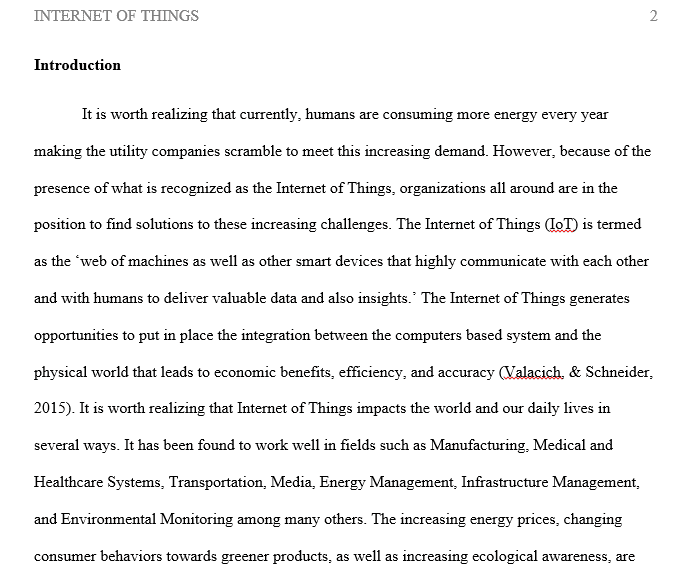The Internet of Things allows objects to be sensed and controlled remotely across existing network infrastructure
The Internet of Things (IoT) Product Proposal Assignment
The Internet of Things allows objects to be sensed and controlled remotely across existing network infrastructure, creating opportunities for more direct integration between the physical world and computer-based systems, and resulting in improved efficiency, accuracy, and economic benefit.
The IoT products and solutions in each of these markets have different characteristics:
Manufacturing:
By networking machinery, sensors, and control systems together, the IoT intelligent systems enable rapid manufacturing of new products, dynamic response to product demands, and real-time optimization of manufacturing production and supply chain networks.
Media:
The combination of analytics for conversion tracking with behavioral targeting and programmatic media has unlocked a new level of precision that enables display advertising to be focused on the devices of people with relevant interests.
Environmental Monitoring:
Environmental monitoring applications of the IoT typically utilize sensors to assist in environmental protection by monitoring air or water quality, atmospheric or soil conditions, and even the movements of wildlife and their habitats. Development of resource-constrained devices connected to the Internet also means that other applications like earthquake or tsunami early-warning systems can also be used by emergency services to provide more effective aid.
Infrastructure Management:
The IoT infrastructure can be used to monitor any events or changes in structural conditions that can compromise safety and increase risk. It can also be utilized to schedule repair and maintenance activities in an efficient manner by coordinating tasks between different service providers and users of these facilities.
Energy Management:
It is expected that IoT devices will be integrated into all forms of energy-consuming devices (switches, power outlets, bulbs, televisions, etc.) and be able to communicate with the utility supply company in order to effectively balance power generation and energy usage.
Medical and Healthcare Systems:
IoT devices can be used to enable remote health monitoring and emergency notification systems. These health monitoring devices can range from blood pressure and heart rate monitors to advanced devices capable of monitoring specialized implants, such as pacemakers or advanced hearing aids. Specialized sensors can also be equipped within living spaces to monitor the health and general well-being of senior citizens while also ensuring that proper treatment is being administered as well as assisting people regain lost mobility via therapy.
Building and Home Automation:
IoT devices can be used to monitor and control the mechanical, electrical, and electronic systems used in various types of buildings (e.g., public and private, industrial, institutions, or residential). Home automation systems, like other building automation systems, are typically used to control lighting, heating, ventilation, air conditioning, appliances, communication systems, entertainment, and home security devices to improve convenience, comfort, energy efficiency, and security.
Transportation:
The IoT can assist in integration of communications, control, and information processing across various transportation systems. Application of the IoT extends to all aspects of transportation systems (i.e. the vehicle, the infrastructure, and the driver or user). Dynamic interaction between these components of a transport system enables inter and intra vehicular communication, smart traffic control, smart parking, electronic toll collection systems, logistic and fleet management, vehicle control, and safety and road assistance.
Large-scale deployments:
There are several planned or ongoing large-scale deployments of the IoT to enable better management of cities and systems. For example, Songdo in South Korea, a fully equipped and wired smart city, is the first of its kind and near completion. Nearly everything in this city is planned to be wired, connected, and turned into a constant stream of data that would be monitored and analyzed by an array of computers with little to no human intervention. Another example of a large-scale deployment is the one completed by New York Waterways in New York City to connect all their vessels and be able to monitor them live 24/7.
Solution preview for the order on The Internet of Things allows objects to be sensed and controlled remotely across existing network infrastructure
APA
1740 words
